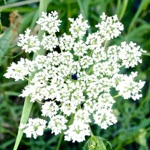Daucus carota
Wild carrot Αγριο καρότο

Apiaceae - carrot family Dicot.
Daucus carota
Wild carrot Αγριο καρότο

Apiaceae - carrot family Dicot.
In early sumer the flowers Daucus carota of appear as a white foam in the green fields and verges and the flowers persist into late august, reappearing after the first autumn rain. The tiny flowers are arranged in creamy white umbels with often a central flower of pink or black, it is thought that this has the appearance of an insect and attracts other insects to the flower head, encouraging pollination. Each umbel is surrounded by a collar of divided bracts. The leaves are typical carrot-like, divided and sub-divided into narrow segments. As the flowers mature they fold inwards to form unusual basket like structures which protect the developing seeds, this gives rise to the alternative English name ; the bird’s nest plant.
The plants are a food crop for animals especially horses and the leaves ,when young can be eaten as horta. The plants have, a long thin white tap root which is edible, but bitter. It is of course related to the orange domesticated carrot (D. carota subspecies sativa*) which has its origins in Central Asia. Pollination of cultivated carrots with the wild variety can result in white rooted specimens developing from the resulting seeds.



Daucus - a Latin name for carrot
carota - from Greek caroto (καρότο)